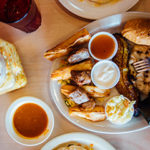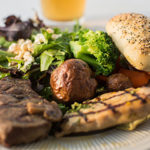Earlier this week, I attended MPI’s World Education Congress in Minneapolis. After learning of my interest in F&B, at least two attendees insisted that I shouldn’t miss Tracy Stuckrath’s session, “Serve This, Not That.” Because she’s both a planner (CSEP, CMM, CHC, CFPM) and someone with food allergies, Stuckrath — who owns Atlanta’s Thrive! Meetings and Events — has spoken and published prolifically on accommodating special diets.
As a food writer, I long ago learned how frustrated chefs can be with the snowballing onslaught of special requests: From diners allergic to gluten or nuts, to those who are kosher or vegan, or even those who eschew carbs, it can feel overwhelming to cook for people these days. But I’d never fully considered how dietary restrictions can complicate a meeting for hundreds, or even thousands, of people. I felt exhausted just listening to the particulars — from melon and MSG allergies to the preferences of those who follow paleo or raw diets.
The frustration buzzed amongst planners, too. While some previous WEC sessions were decidedly more buoyant, this one had more of a determined feel. “You come to a point where you’re just like, c’mon,” sighed one planner (presumably about food).
Stuckrath adopts a measured, can-do approach to the F&B obstacle course, and she explained why that matters: 15 million Americans have food allergies, and “understanding those intricacies” is not only vital to a successful meeting, but can help avoid lawsuits (on the basis of discrimination) or even death. At the same time, ordering special meals that go uncollected by attendees can incur staggering expense. “We’ve got a lot on our plate already,” said Stuckrath. “How do you take small steps to implement this stuff, and learn?”
She shared some basic but useful facts: Eight foods — eggs, milk, soy, wheat, shellfish, tree nuts, peanuts, and fish — cause 90 percent of all allergic reactions. Pink peppercorns are related to cashews, and can be deadly to someone with a nut allergy. Steel-cut oats are not necessarily gluten-free, unless they are certified as such. There are 57 different words for sugar on food labels. Then there are the subtle particulars of certain diets: Paleo eaters avoid processed foods, sugars, sweet fruit, beans, dairy and seed oils, while vegans can’t eat eggs or honey in addition to milk and meat (and some wines are filtered with eggs or fish skin, Stuckrath pointed out).
It was enough to make a chef’s, or a planner’s, head implode. Stuckrath was armed with tips, however: Cover your bases during site visits, in contracts with suppliers, and during registration by communicating as clearly and fully as possible. Confirm that catering staff is properly trained in procedures and emergency plans. Have access to an EpiPen. And most saliently, streamline a meal plan to serve foods that can feed broad swaths of eaters. “Say you have 100 people and 49 different dietary requests. Instead of serving 50 meals, reduce that to 10 different meals that can be served,” she pointed out.
The overarching message seemed to be that whatever the causes of our skyrocketing allergies and intolerances — or even preferences — they’re not going away anytime soon. Rolling with restrictions results in repeat business, less waste, more trust, and sometimes even budget savings for planners. In an industry that spends $54.5 billion on F&B each year, they’re ideas worth chewing on.





